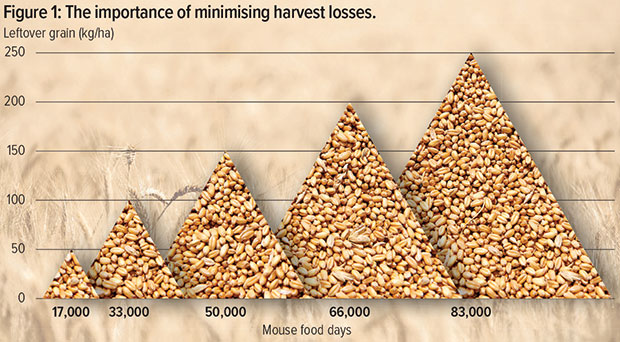Western Australia grain growers in areas where mouse numbers are at moderate levels are advised to prioritise minimising grain on the ground after harvest to help reduce the potential for an outbreak ahead of sowing in 2023.
With Grain Industry Western Australia’s (GIWA) October crop report predicting harvest yields close to last year’s record-breaking figure of 24 million tonnes, it is likely that availability of food and shelter for mice will again be high in paddocks this year.
Pest experts undertaking research with investment from the Grains Research and Development Corporation (GRDC) are encouraging growers to harvest as cleanly as possible and practice good farm hygiene, especially around grain storage facilities, to reduce the availability of food.
Leading mouse researcher Steve Henry from CSIRO, Australia’s national science agency, says food resources left in paddocks after harvest could sustain mouse breeding over summer and lead to higher mouse numbers when next year’s winter crops are sown.
“Yields are likely to be high for many growers in Western Australia this year which means the likelihood of grain being left on the ground is also high,” says Mr Henry, whose mouse-related research is through GRDC and CSIRO co-investment.
Mr Henry recommended growers undertake a clean harvest. “Take the time to ensure the header is set up properly – not just at the start of harvest, but also when changing crops and paddocks.
“Measure what’s coming out of the front and back of the machine. The less there is, the less food for mice and the more chance they will take-up bait before sowing next season if populations are still a concern. And if you can avoid losing that grain, you are putting more grain in the header bin and money in your pocket.”
Research conducted by Grower Group Alliance (GGA), as part of a GRDC investment, has determined that more than $300 million worth of grain was likely left in paddocks last season from machine losses across all crops grown in WA.
Mr Henry says it is important to remember that mice eat about three grams of food per day.
“Even if you think your paddocks are clean, remember only 150kg/ha of alternative food across your paddock equates to 50,000 mouse days of food,” he says.

CSIRO’s Steve Henry said 150kg/ha of alternative food across the paddock equates to 50,000 mouse days of food. Graphic: Steve Henry, CSIRO.
“Also consider post-harvest stubble management like grazing and be proactive in spraying-out summer germinations. Any steps to reduce mouse food in the system helps to reduce mouse numbers over summer and minimise the risk for any potential mouse damage at sowing next season.”
GRDC Crop Protection Manager – West Georgia Megirian says that mouse management requires an integrated approach and a key part of this is the reduction of alternative food sources.
“Growers should also be aware of the 14-day withholding period before harvest. It may not be possible for growers to bait in crops before harvest because of restrictions with label conditions,” Ms Megirian says.
The latest monitoring undertaken by Farmanco Management Consultants, Great Northern Rural Services and Ravensthorpe Agricultural Initiative (RAIN) through GRDC investments indicates that mouse numbers in WA have been higher than usual across all port zones this year.
GRDC partnered with CSIRO to run “Mouse Roadshows” across grain growing regions in March and August, visiting 32 locations with 542 growers and advisers in attendance. The series ran in collaboration with local industry partners and grower groups, focusing on awareness, monitoring and practical information for on-farm management.
Mr Henry urged growers to report and map mouse activity – presence and absence – using MouseAlert and via Twitter using @MouseAlert so other growers can see what activity is being observed in their neighbourhood.
Practical tips for growers at harvest include:
- If mouse abundance is high and baiting is warranted, be aware of the withholding period before harvest.
- Harvest crops before they are overripe to minimise pod shatter or grain loss.
- Minimise spilled grain in paddocks. This is key to limiting mouse populations and damage in next year’s crop. Set harvesters to minimise grain loss and monitor how much grain is left in the paddock.
- Use seed destroyers to reduce potential food sources for mice.
- Clean up any spills of grain around field bins, augers, silo bags and other grain storage.
- Be aware that windrowed crops provide mice with a good source of food and shelter. In paddocks with crops that will be windrowed, efforts should be made early to reduce the number of mice.
- Roll standing stubble to increase exposure of mice to predators.
- Grazing stubbles can help clean up residual grain, but sufficient ground cover should be left to minimise erosion.
- Remove or reduce plant material, rubbish and general clutter around buildings, silos and fodder storage as these all provide protection for mice.
GRDC has invested $7.5 million in a major national mouse-related research, development and extension program that is continuing to reveal new insights about mice in Australian broadacre cropping systems. The work is investigating mouse biology, ecology and bait efficacy.
Further resources are available on the Mouse Management page on GRDC’s website.

























































